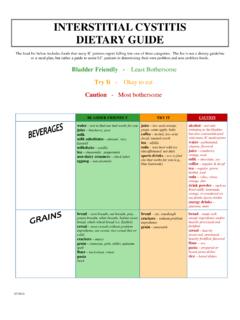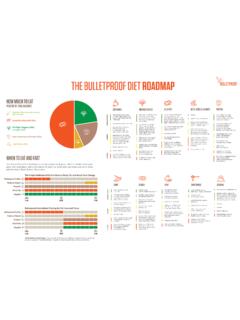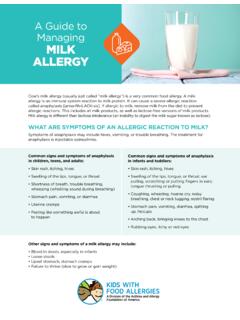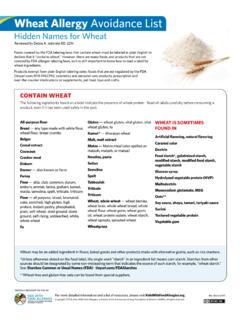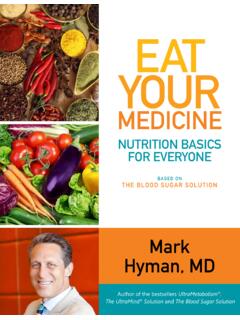Transcription of Infant and Pediatric Formulas: Choices and Indications
1 6/5/20171 Jan Cox, MS RDNI nfant and Pediatric Formulas: Choices and IndicationsObjectives Identify compositional differences of contract formulas for infants and toddlers Identify Indications for use of specialty formulas for infants and toddlers Discuss methods to handle common Infant feeding problems6/5/20172 Outline Overview of contract Infant and Pediatric formulas Indications for special Infant and Pediatric formulas Case StudiesBenchmark for Infant NutritionBreastfeeding is the preferred method of Infant feeding to meet optimal growth and
2 Development. Benefits are numerous: protein quality and quantity Low renal solute load Ease of digestion Immunologic agents Decreased incidence/severity of diarrhea Enhanced cognitive development Protection against necrotizing enterocolitis6/5/20173 Barriers to Breastfeeding Young maternal age Lack of prenatal care/education Lack of professional knowledge/support Lack of support in the workplace formula advertising and availabilityOver 80% of infants in the United States are ever breast f e d , b u t.
3 Only 44% are exclusively breastfed at 3 months and only 52% are still receiving some breast milk at 6 in Michigan (WIC) (3/13/2017) Initiated/ever ( ) Breastfeeding at 4 weeks( ) Breastfeeding at 2 months( ) Breastfeeding at 6 months ( ).. w h i c h t r a n s l a t e s t o .. No breast milk ( ) formula at 4 weeks( ) formula at 2 months( ) formula at 6 months ( )6/5/20174So, in our quest for a substitute breast (milk), at least for infants,what are the options? Infant formula ClassificationsStandard Formulas Cow s Milk Based Standard Partially hydrolyzed protein Prebiotics Rice starch Probiotics Soy protein BasedSpecialty Formulas Extensively hydrolyzed protein Free Amino Acid Lactose-Free Preterm Infant Preterm Discharge Lower Mineral_____ Human Milk Fortifier6/5/20175 Pediatric formula Classifications Standard Oral 1 kcal/mL kcal/mL With or without fiber Standard TF With or without fiber Casein based Blenderized foods Reduced calorie Special
4 Formulas Peptide based Amino acid based Fat modified Clear liquidIngredients Proteins Fats Carbohydrates Prebiotics/Fibers Probiotics6/5/20176 protein Infant formulas Cow s milk casein and/or whey Soy milk Goat s milk Amino acids Pediatric products Cow s milk casein and/or whey Meat (chicken) and pea protein Amino acidsProteinThe number of amino acids in a protein can be approximated from its molecular weight, measured in daltons, with less than 3kD defining hypoallergenic . Whole casein 12-25 kD Bovine whey 14-67 kD Partially hydrolyzed - < 5 kD Extensively hydrolyzed - < 3 kD Amino acids average kD6/5/20177 Fat LCT: corn, palm, soy, high oleic safflower or sunflower, canola, etc.
5 DHA (algae) and ARA (fungus) MCT: Medium chain triglycerides 8-12 carbon Do not require bile or lipase to be absorbed Essential fatty acids: 18 carbon Linoleic acid Linolenic acidCarbohydrate Lactose Natural mammalian carbohydrate Requires lactase, produced at the tips of the microvilli Sucrose Blenderized Pediatric products also contain fruit and/or juice Corn derived carbohydrates Complex Simple6/5/20178 Corn Derived CarbohydratesBrooks JR, Griffin VK. Cereal Chem. 1987. 64 : corn syrup solids DE DE 24 DE : maltodextrins DE DE DE Breast milk content Galacto- and fructo-oligosaccharides 200 distinctly different structures 5-10 g/L significant quantities Infant formula Galacto-oligosaccharides Polydextrose Pediatric formula Insoluble fiber pea, soy, oat bran Soluble fiber FOS, inulin (chicory), oat fiber6/5/20179 Probiotics live bugs!
6 Of course, not every live bug, but: Live microorganisms which when. administered in adequate amounts confer a health benefit on the host. Standard Products Infant Products: Enfamil Gentlease Reguline Enfamil AR Soy Pediatric Products: Pediasure (oral) Boost Kids (oral) Nutren (TF) Compleat Pediatric (TF)6/5/201710 Cow s Milk - Infant Indication: Infants 0-12 months protein : 60:40 whey casein ratio Ratio similar to mature breast milk -Lactoglobulin not -Lactalbumin Carbohydrate: Lactose Prebiotics for normal gut flora GOS galactooligosaccharides Polydextrose DHA/ARA fatty acids Worldwide average levels Supports mental, visual, and immune developmentCow s Milk Partially hydrolyzed Indication: fussiness and gas protein : partially hydrolyzed Advertised as easy to digest 60.
7 40 whey casein ratio Uses soy based enzymes Do not use for milk allergy No claims for allergy prevention Carbohydrate Corn syrup solids (80%) Lactose (20%) No prebiotics DHA/ARA fatty acids 6/5/201711 Cow s Milk 3 in 1 Indications : softer stools protein : Partially hydrolyzed Nonfat cow s milk Whey protein concentrate Soy based enzymes Carbohydrate: Maltodextrin 50% Lactose 50% Prebiotics: GOS/Polydextrose DHA/ARA fatty acidsCow s Milk Based - Rice starch Indication: Uncomplicated GER/regurgitation with appropriate positioning and feeding Viscosity 10 times routine formula Flows well through standard nipples Viscosity increases 12 fold in stomach acid Do not concentrate to more than 24 Cal/oz May be useful for some infants as a thickened liquid to manage suck/swallow dysfunction per OT/SLP protein : 20:80 whey: casein ratio Carbohydrate: Rice starch (29% in powder; 20% in liquid) Lactose (59% in powder; 66% in liquid) Maltodextrin (12% in powder.)
8 14% in liquid) Prebiotics: GOS/Polydextrose DHA/ARA fatty acids6/5/201712 Soy Indications : galactosemia, lactose intolerance, or vegan diet Do not use for preterm Infant < kg or 4 pounds birth weight No proven benefit for colic or allergy prevention in high risk family Use with caution in cow s milk allergy: oIgE : if + milk,10-14% + soyoNon-IgE : if + milk, 30-60% + soy protein : soy Carbohydrate: corn syrup solids DHA/ARA fatty acidsAllergy/Intolerance: IgE Mediated Occur immediately with 1-2 hours Cutaneous urticaria/angioedema: hives Gastrointestinal oral itching/abdominal pain/vomiting diarrhea Respiratory wheeze, laryngeal edema, rhinocongitivitis Anaphylaxis (milk = 8-15% of food related fatal or near fatal reactions.
9 Soy < 1%) 10-14% of milk + may react to soy protein 10% of milk + may also react to extensively hydrolyzed protein6/5/201713 Allergy/Intolerance: Mixed Atopic dermatitis 40% may be food related Milk + eggs + soy + wheat = 90% allergenic foods Gastrointestinal Eosinophilic esophagitis feeding problems, vomiting, abdominal pain, dysphagia, GER Eosinophilic gastroenteritis abdominal pain, vomiting, diarrhea, weight lossAllergy/Intolerance Non-IgE Food protein induced enterocolitis Profuse vomiting and diarrhea within 2-3 hours Dehydration/lethargy Occult blood loss Fecal smears.
10 Leukocytes and eosinophils Failure to thrive/ hypoalbuminemia 45% (range 30-64%) milk + also react to soy 30% of milk + also react to extensively hydrolyzed protein GER +/- not sole symptom Colic +/- not sole symptom Pulmonary (rare) cough, wheeze, dyspnea, recurrent otitis media, nasal congestion, anorexia6/5/201714 Soy AAP Position Paper 2008 Limited Indications for use of soy formula Market share 25% of Infant formula prior to AAP statement, and 13% in 2009 Use in Michigan WIC Program 19% of all infants in 2008, down to <7% Pediatric Standard Products(oral) Pediasure Milk protein concentrate MCT:LCT 20:80.



